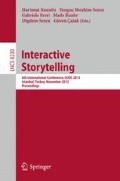Abstract
The concept of character believability is often used in interactive narrative research hypothesis. In this paper we define believability metrics using perceived believability dimensions and discuss how they can be accessed. The proposed dimensions are: behavior coherence, change with experience, awareness, behavior understandability, personality, visual impact, predictability, social and emotional expressiveness.
Access this chapter
Tax calculation will be finalised at checkout
Purchases are for personal use only
Preview
Unable to display preview. Download preview PDF.
References
Bartneck, C.: How convincing is mr. data’s smile: Affective expressions of machines. User Modeling and User-Adapted Interaction 11(4), 279–295 (2001)
Bates, J.: The role of emotion in believable agents. Commun. ACM 37(7), 122–125 (1994), 176803
Coleridge, S.T.: Biographia Literaria: Biographical Sketches of my Literary Life & Opinions. Princeton University Press (1985)
Coleridge, S.T.: Lyrical Ballads. Penguin Classics (2007)
Ekman, P.: An argument for basic emotions. Cognition & Emotion 6(3-4), 169–200 (1992)
Frasca, G.: Video games of the oppressed (2006)
Gomes, P.F., Martinho, C., Paiva, A.: I’ve been here before! location and appraisal in memory retrieval. In: Proceedings of the 10th International Conference on Autonomous Agents and Multiagent Systems, Taipei, Taiwan, pp. 1039–1046. IFAAMAS (2011)
Gorman, B., Thurau, C., Bauckhage, C., Humphrys, M.: Believability testing and bayesian imitation in interactive computer games. In: Nolfi, S., Baldassarre, G., Calabretta, R., Hallam, J.C.T., Marocco, D., Meyer, J.-A., Miglino, O., Parisi, D. (eds.) SAB 2006. LNCS (LNAI), vol. 4095, pp. 655–666. Springer, Heidelberg (2006)
Lasseter, J.: Principles of traditional animation applied to 3d computer animation. SIGGRAPH Comput. Graph. 21(4), 35–44 (1987)
Lester, J.C., Stone, B.A.: Increasing believability in animated pedagogical agents. In: Proceedings of the First International Conference on Autonomous Agents, pp. 16–21. ACM (1997)
Bryan Loyall, A.: Believable Agents: Building Interactive Personalities. PhD thesis, Carnegie Mellon University (1997)
Magerko, B.: Measuring dramatic believability. In: Intelligent Narrative Technologies, pp. 79–82 (2007)
Mateas, M.: An oz-centric review of interactive drama and believable agents. In: Veloso, M.M., Wooldridge, M.J. (eds.) Artificial Intelligence Today. LNCS (LNAI), vol. 1600, pp. 297–328. Springer, Heidelberg (1999)
Mateas, M., Stern, A.: Façade: An experiment in building a fully-realized interactive drama. In: Game Developers Conference, Game Design Track, vol. 2, p. 82 (2003)
McKee, R.: Story: Substance, Structure, Style, and the Principles of Screenwriting. Harper Collins Publishers (October 1997)
Ortony, A.: On making believable emotional agents believable. In: Emotions in Humans and Artifacts. MIT Press (2003)
Paiva, A., Dias, J., Sobral, D., Aylett, R., Sobreperez, P., Woods, S., Zoll, C., Hall, L.: Caring for agents and agents that care: Building empathic relations with synthetic agents. In: Proceedings of the Third International Joint Conference on Autonomous Agents and Multiagent Systems, vol. 1, pp. 194–201. IEEE Computer Society (2004)
Riedl, M.O., Young, R.M.: An objective character believability evaluation procedure for multi-agent story generation systems. In: Panayiotopoulos, T., Gratch, J., Aylett, R.S., Ballin, D., Olivier, P., Rist, T. (eds.) IVA 2005. LNCS (LNAI), vol. 3661, pp. 278–291. Springer, Heidelberg (2005)
Thomas, F., Johnston, O.: Disney Animation: The Illusion of Life. Abbeville Press, New York (1981)
Author information
Authors and Affiliations
Editor information
Editors and Affiliations
Rights and permissions
Copyright information
© 2013 Springer-Verlag Berlin Heidelberg
About this paper
Cite this paper
Gomes, P., Paiva, A., Martinho, C., Jhala, A. (2013). Metrics for Character Believability in Interactive Narrative. In: Koenitz, H., Sezen, T.I., Ferri, G., Haahr, M., Sezen, D., C̨atak, G. (eds) Interactive Storytelling. ICIDS 2013. Lecture Notes in Computer Science, vol 8230. Springer, Cham. https://doi.org/10.1007/978-3-319-02756-2_27
Download citation
DOI: https://doi.org/10.1007/978-3-319-02756-2_27
Publisher Name: Springer, Cham
Print ISBN: 978-3-319-02755-5
Online ISBN: 978-3-319-02756-2
eBook Packages: Computer ScienceComputer Science (R0)

